Last Updated on December 15, 2023
The main difference between Arabica and Robusta coffee is that Arabica coffees have more complex flavor profiles because their shrubs have fewer branches and cherries competing for nutrients. They also have more genetic complexity.
Most of the world’s coffee is produced from these two main species: Coffea arabica (Arabica) and Coffea canephora (Robusta). Arabica comprises approximately 60-70 per cent of global coffee production. There are many other differences between these two species of coffee plant, which lead to vastly different flavor profiles and coffee-drinking experiences.
But why do Arabica and Robusta taste so different? Are the differences that are commonly noted supported by science?
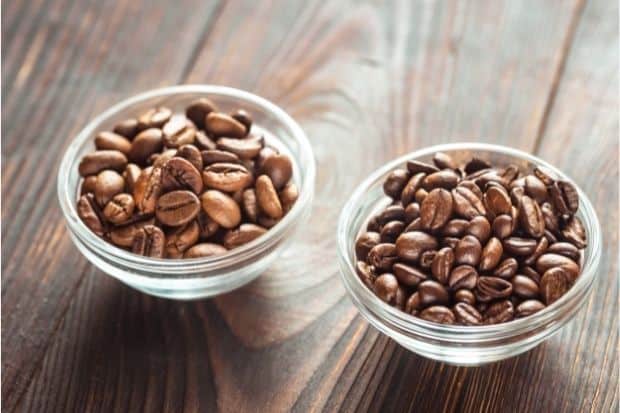
Botanical differences between Arabica and Robusta
Compared to Arabica, Robusta coffee shrubs are denser, bulkier, and optimally grown in environmental conditions of lower elevations, higher temperatures, and more rainfall. Robusta shrubs are less sensitive and better able to withstand adverse environmental conditions.
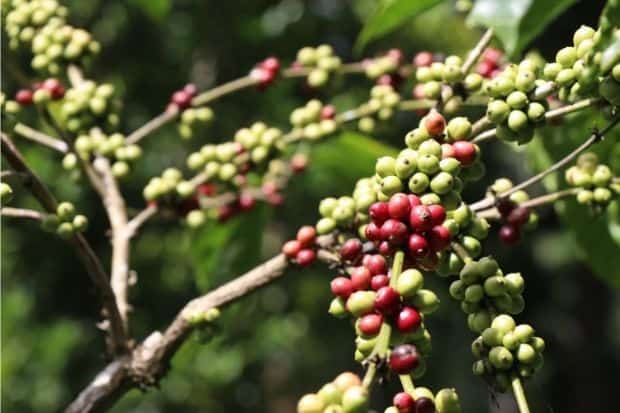
Arabica shrubs are more susceptible to pests, require more shade and higher elevations, and are often grown in conjunction with other fruits and plants to shield them from direct sunlight. Arabica shrubs also produce a lower yield and typically take longer to grow, making Arabica coffee more expensive than Robusta.
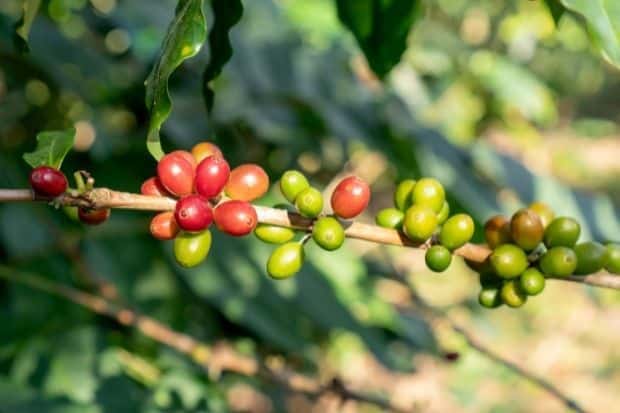
Arabica coffee beans are more oval-shaped and slightly larger, whereas Robusta coffee beans are rounder and slightly smaller.
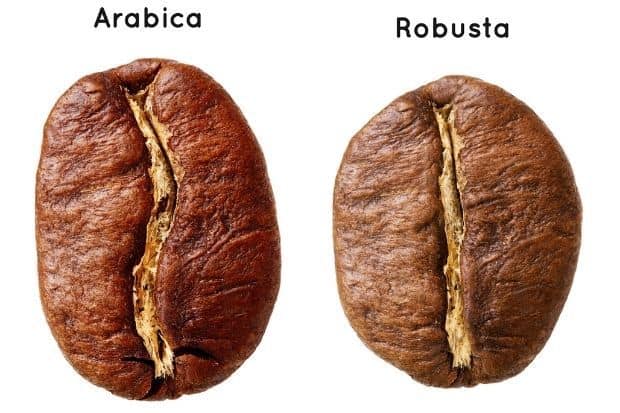
High-quality Arabica is typically grown in tropical climates near the equator. The effects of climate change are certainly a concern for the coffee industry, and will likely impact where and how coffee is grown. One study modeled the effects of climate change on Arabica and Robusta plants, and found that both species will be impacted by the effects of climate change. Higher temperatures are expected to reduce yields of Arabica, while Robusta may suffer from an increased variability of intra-seasonal temperatures.
Flavor differences between Arabica and Robusta
Because Arabica shrubs have fewer branches and fewer cherries competing for nutrients, the coffee cherries have access to more nutrients, which can lead to more complex flavor profiles than Robusta. Arabica plants also have more chromosome pairs than Robusta plants, so there is more genetic complexity as well. On the other hand, Robusta cherries don’t receive as many nutrients and have fewer chromosome pairs, both contributing to simpler flavor profiles.
Although there are certainly some flavor differences between Robusta and Arabica that are generally agreed upon in the industry, it is important to remember that there is a lot of intraspecies variability as well. Different origins provide vastly different environmental growing conditions that give beans unique, distinct characteristics that are not exhibited in beans from other locations.
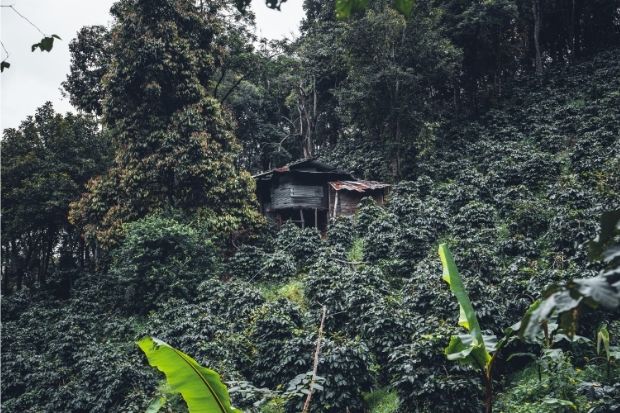
Overall, Arabica is typically characterized by a sweeter, milder, more complex flavor, and may contain any of the following array of flavor notes: fruity, caramel, chocolate, nutty, buttery, malty, floral, berries, grassy, woody, or many other possibilities.
Robusta, on the other hand, is typically characterized by a stronger, heavier, harsher, more bitter, and less complex flavor, and may contain flavor notes such as rubbery, earthy, woody, dark chocolate, grainy, peanut, smoky, or burnt.
Due to the higher levels of bitterness, Robusta is usually roasted darker to make the bitterness less apparent. However, Arabica can be roasted to any degree without bitterness being as much of a concern. Different degrees of roasting bring out different flavors in Arabica, even in the same batch of beans.
Bitterness and caffeine
In order to better resist pests and animals, the Robusta beans produce more bitter compounds than Arabica beans. One of those bitter molecules is caffeine, known for its stimulant effects. This is why Robusta typically contains approximately twice the caffeine as Arabica. Whether the higher caffeine content in Robusta is a pro or a con—well, that’s up to you!
Sugar and fat
Another flavor advantage that Arabica has over Robusta is that it typically contains higher concentrations of sugar and lipids (fat). Sugar and fat are both well known in the food industry to increase the pleasantness of a food or beverage. In coffee, higher levels of sugar and lipids can result in a sweeter taste, less bitter taste, better flavor delivery, and a more desirable mouthfeel.
Aromatics
“Flavor” includes more than just the basic tastes you perceive on your tongue (mainly sour, bitter, and sweet in coffee). The majority of the flavor you perceive is composed of aromatic compounds (molecules) that travel up your nasal passage to your smell receptors. The types of aromatic compounds that are present in coffee vary widely and depend on a number of factors, from origin to roast degree.

A recent study characterized the volatile (aromatic) compounds of Arabica and Robusta medium-roasted coffees with a laboratory technique called chromatography. The flavor profiles were hugely variable, but some trends were found, similar to findings from previous studies.
Robusta tends to have higher levels of molecules called pyrazines with flavors described as nutty, chocolate, peanut, hazelnut, rancid peanuts, roasted, smoky, rubbery burnt, earthy, grassy, and cooked spinach.
In contrast, Arabica tends to have higher levels of various groups of molecules with sweet, woody, almond, cocoa, rum, fruity, buttery, coffee-like, caramelized, and malty flavors.
Acidity
“Acidic” is one of those terms that coffee drinkers use frequently to describe coffee without agreeing on a singular definition—that is, it is used to describe many different sensations and individual experiences. In coffee chemistry, however, a coffee that is more “acidic” than another denotes that there is a higher concentration of acids in said coffee. Acids in coffee are divided into two main categories: organic acids (OAs) and chlorogenic acids (CGAs). A recent meta-analysis study found several prominent differences in the acidic profiles of Arabica versus Robusta coffee.
Overall, total OAs are higher in Robusta than Arabica. In particular, Robusta has higher levels of formic acid and acetic acid than Arabica, which are both sour-tasting, with some bitterness (formic) and vinegar aroma (acetic). Citric acid (sour), malic acid (sour), and quinic acid (sour, bitter, and mouth-drying) are all found in higher levels in roasted Robusta compared to roasted Arabica.
Chlorogenic acids are naturally occurring antioxidants that function as part of the plant’s self-protection mechanism in warding off pests and disease. Overall, total chlorogenic acids (CGAs) are higher in Robusta than Arabica, but the difference may not be as pronounced as previously thought. For both Arabica and Robusta, progressive roasting decreases the concentration of all CGAs, with lighter roasts having the highest CGA levels. In the study mentioned, the total amount of CGA present was more dependent on roast level than the species (Arabica vs. Robusta).
According to the above, it seems that chemically, Robusta is more acidic than Arabica. However, there are many non-scientific coffee articles that claim that Arabica is more acidic and that Robusta has “low acidity.”
Perhaps, in a way, both are correct.
From a chemical composition perspective, Robusta is certainly more acidic. However, from a sensory perception perspective, it is possible that, due to the high levels of bitterness and burnt flavor of darkly roasted Robusta coffee, there is a masking effect that decreases the perception of sourness coming from the acids in roasted Robusta. Therefore, the Robusta coffee would taste more bitter and less sour. More research remains to be done on the role of various acids in coffee flavor.
Uses of Arabica vs. Robusta
While Arabica can be found in the form of single-origin coffee or blends, 100-per-cent single-origin Robusta is almost never found in the U.S. Rather, Robusta is typically used as part of espresso blends, as filler in mass produced coffee, and in instant coffee. Part of the reason that Robusta works well for espresso blends is that it has more caffeine and produces a better crema (the creamy, foamy layer found on top of an espresso shot) than Arabica.
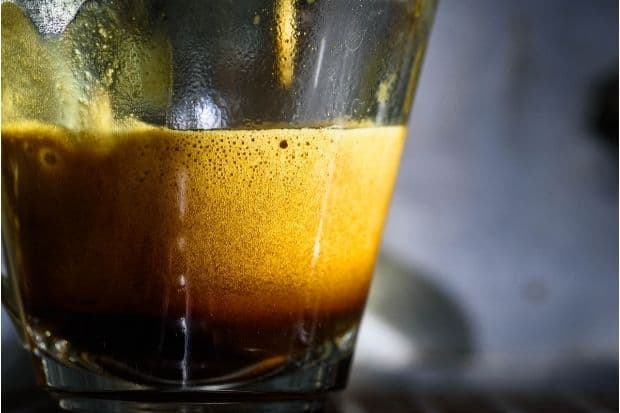
Given the susceptibility of Arabica to climate change, some roasters are trying to give Robusta another chance. If Robusta beans are good quality and roasted carefully, you can get an espresso that brings out the best in Robusta: a strong, chocolatey, dense, and deep flavor. Scientists are also doing research to engineer coffee plants that would produce the best of both worlds: a resilient coffee shrub that can withstand climate change and still produce the pleasant and complex flavor profile of a good quality Arabica.
Resources
- Bunn et al. 2014. A bitter cup: climate change profile of global production of Arabica and Robusta coffee. https://link.springer.com/article/10.1007/s10584-014-1306-x
- Caporaso et al. 2018. Variability of single bean coffee volatile compounds of Arabica and robusta roasted coffees analysed by SPME-GC-MS. https://www.sciencedirect.com/science/article/pii/S0963996918302679
- Yeager et al. 2021. Acids in coffee: A review of sensory measurements and meta-analysis of chemical composition. https://www.tandfonline.com/doi/full/10.1080/10408398.2021.1957767

